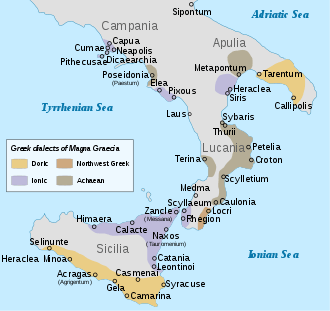Taormina
Taormina (UK: /ˌtɑːɔːrˈmiːnə/ TAH-or-MEE-nə,[2] US: /-nɑː/ -nah, also /taʊərˈ-/ towr-,[3][4] Italian: [ta.orˈmiːna]; Sicilian: Taurmina; Latin: Tauromenium; Ancient Greek: Ταυρομένιον, romanized: Tauroménion) is a comune (municipality) in the Metropolitan City of Messina, on the east coast of the island of Sicily, Italy. Taormina has been a tourist destination since the 19th century. Its beaches on the Ionian sea, including that of Isola Bella, are accessible via an aerial tramway built in 1992, and via highways from Messina in the north and Catania in the south. On 26–27 May 2017 Taormina hosted the 43rd G7 summit.
Taormina | |
|---|---|
| Comune di Taormina | |
.jpg) Taormina and Mount Etna as seen from the Ancient Theatre | |
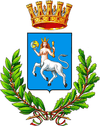 Coat of arms | |
Location of Taormina 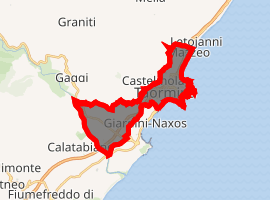
| |
 Taormina Location of Taormina in Italy 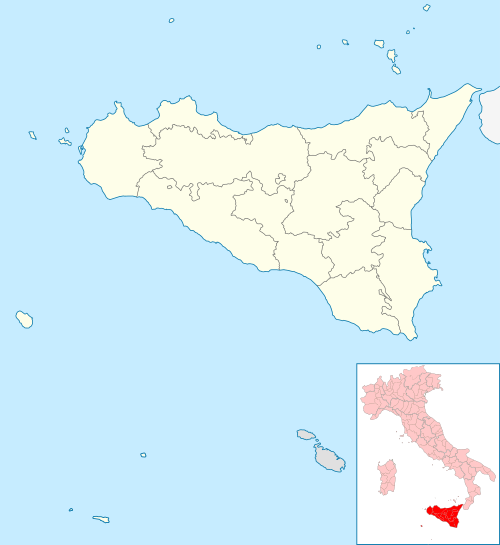 Taormina Taormina (Sicily) | |
| Coordinates: 37°51′8″N 15°17′31″E | |
| Country | Italy |
| Region | Sicily |
| Metropolitan city | Messina (ME) |
| Frazioni | Mazzeo, Trappitello, Villagonia, Chianchitta, Spisone, Mazzarò |
| Government | |
| • Mayor | Eligio Giardina |
| Area | |
| • Total | 13 km2 (5 sq mi) |
| Elevation | 204 m (669 ft) |
| Population (2018-01-01)As of March 2009 | |
| • Total | 11,075 |
| • Density | 850/km2 (2,200/sq mi) |
| Demonym(s) | Taorminesi |
| Time zone | UTC+1 (CET) |
| • Summer (DST) | UTC+2 (CEST) |
| Postal code | 98039 |
| Dialing code | 0942 |
| Patron saint | San Pancrazio di Taormina |
| Saint day | 9 July |
| Website | Official website (in Italian) |
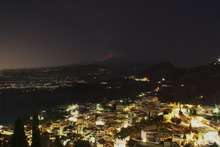
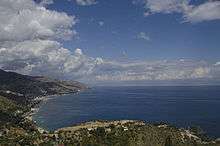
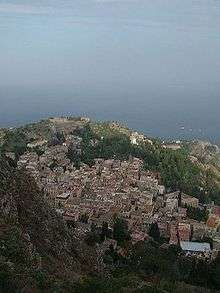
History
Ancient Tauromenion
The area around Taormina was inhabited by the Siculi even before the Greeks arrived on the Sicilian coast in 734 BC to found a town called Naxos. The theory that Tauromenion was founded by colonists from Naxos is confirmed by Strabo and other ancient writers. Pseudo-Scylax writes that it was a Greek city.[5]
The new settlement seems to have risen rapidly to prosperity, and was apparently already a considerable town at the time of Timoleon's expedition in 345 BC. It was the first place in Sicily where that leader landed, having eluded the vigilance of the Carthaginians, who were guarding the Straits of Messina, and crossed direct from Rhegium (modern Reggio di Calabria) to Tauromenium.[6] The city was at that time still under the government of Andromachus, whose mild and equitable administration is said to have presented a strong contrast with that of the despots and tyrants of the other Sicilian cities. He welcomed Timoleon with open arms, and afforded him a secure resting place until he was enabled to carry out his plans in other parts of Sicily.[7] Andromachus was not deprived of his position of power when all the other tyrants were expelled by Timoleon, but was permitted to retain it undisturbed till his death.[8] Little is recorded about Tauromenium for some time after this. It is probable that it passed under the authority of Agathocles, who drove the historian Timaeus into exile; and some time after this it was subject to a domestic despot of the name of Tyndarion, who was contemporary with Hicetas of Syracuse and Phintias of Agrigentum.[9] Tyndarion was one of those who concurred in inviting Pyrrhus into Sicily (278 BC), and when that monarch landed with his army at Tauromenium, joined him with all his forces, and supported him in his march upon Syracuse.[10] A few years later we find that Tauromenium had fallen into the power of Hieron II of Syracuse, and was employed by him as a stronghold in the war against the Mamertines. (Id. p. 497.) It was also one of the cities which was left under his dominion by the treaty concluded with him by the Romans in 263 BC.[11]
There is no doubt that Tauromenium continued to form a part of the kingdom of Syracuse until the death of Hieron, and that it only passed under the government of Rome when the whole island of Sicily was reduced to a Roman province; but we have scarcely any account of the part it took during the Second Punic War, though it would appear, from a hint in Appian,[12] that it submitted to Marcellus on favorable terms; and it is probable that it was on that occasion it obtained the peculiarly favored position it enjoyed under the Roman dominion. For we learn from Cicero that Tauromenium was one of the three cities in Sicily which enjoyed the privileges of a civitas foederata or allied city, thus retaining a nominal independence, and was not even subject, like Messina, to the obligation of furnishing ships of war when called upon.[13] The city, however, suffered severe calamities during the Servile War in Sicily (134–132 BC), having fallen into the hands of the insurgent slaves, who, on account of the great strength of its position, made it one of their chief posts, and were able for a long time to defy the arms of the consul Publius Rupilius. They held out until they were reduced to the most fearful extremities by famine, when the citadel was at length betrayed into the hands of the consul by one of their leaders named Sarapion, and the whole of the survivors put to the sword.[14]
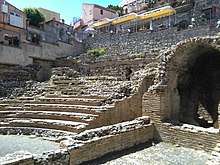
Tauromenium again played a conspicuous part during the wars of Sextus Pompeius in Sicily, and, from its strength as a fortress, was one of the principal points of the position which he took up in 36 BC, for defence against Octavian. It became the scene also of a sea-fight between a part of the fleet of Octavian, commanded by the triumvir in person, and that of Pompeius, which terminated in the defeat and almost total destruction of the latter.[15] In the settlement of Sicily after the defeat of Pompeius, Tauromenium was one of the places selected by Augustus to receive a Roman colony, probably as a measure of precaution, on account of the strength of its situation, as we are told that he expelled the former inhabitants to make room for his new colonists.[16] Strabo speaks of it as one of the cities on the east coast of Sicily that was still subsisting in his time, though inferior in population both to Messana and Catana.[17] Both Pliny and Ptolemy assign it the rank of a colonia,[18] and it seems to have been one of the few cities of Sicily that continued under the Roman Empire to be a place of some consideration. Its territory was noted for the excellence of its wine,[19] and produced also a kind of marble which seems to have been highly valued.[20] Juvenal also speaks of the sea off its rocky coast as producing the choicest mullets.[21] The Itineraries place Tauromenium 32 miles from Messina, and the same distance from Catania.[22]
Middle Ages
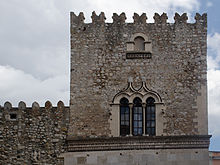
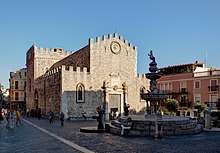
After the fall of the Western Roman Empire, Taormina continued to rank as one of the more important towns of Sicily, and because of the strength of its position was one of the last places that was retained by the Eastern Roman (Byzantine) emperors; but it was taken by the Fatimids in 962 after a siege of 30 weeks. Taormina was renamed "Al-Mu'izziyya" in honour of Caliph al-Mu'izz (reigned 953–75). Muslim rule of the town (see History of Islam in southern Italy) lasted until 1078, when it was captured by the Norman count Roger I of Sicily. At this time Taormina and the surrounding Val Demone were still predominately Greek speaking.[23]
After the fall of the Normans and of their German (imperial) heirs, the Hohenstaufen, Taormina followed the history of Sicily under the Angevins and then the Crown of Aragon. In 1410 King Martin II of Sicily was elected here by the Sicilian Parliament. Later Taormina was under Spanish suzerainty, receiving the status of "city" in the 17th century.
In 1675 it was besieged by the French, who had occupied Messina. The troops sacked the town destroying the top part of the Middle Tower that divides Taormina between the ancient Greco-Roman section and the later medieval southern zone.
Modern age
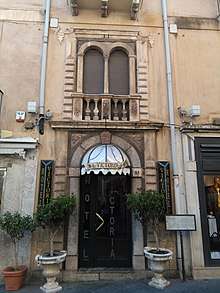
Under the Bourbon dynasty of the Kingdom of Two Sicilies, which lasted until 1860, Taormina did not have a relevant role; however, it obtained an easier access when part of the Catrabico promontory was partially cut and a seaside road connecting it to Messina and Catania was created. It received also a station on the second-oldest railroad in the region.
There is some speculation about Taormina being an early gentlemen's destination.[24] Capri had a similar reputation, as tolerant of gay men and artists. Taormina's first important tourist was Johann Wolfgang Goethe, who exalted it in Italian Journey, a record of his 1786 journey published in 1816. Starting from the 19th century Taormina became a popular tourist resort in the whole of Europe: people who visited Taormina include Oscar Wilde, Nicholas I of Russia, Johann Wolfgang von Goethe, Friedrich Nietzsche (who here wrote his Thus Spoke Zarathustra), Richard Wagner and many others. In the late 19th century the city gained further prominence as the place where Wilhelm von Gloeden worked most of his life as a photographer of predominantly male nudes.
Also credited for making Taormina popular was Otto Geleng (1843-1939), a German landscape painter who settled there from the 1860s. He was one of the first artists to capture the beauties of Sicily, and his exhibitions in Berlin and Paris lured northern Europeans to see for themselves. He married an Italian woman and settled in Taormina, renovating a palazzo into the first full-scale hotel to greet these visitors.
In 1905, the English artist Robert Hawthorn Kitson, heir to Kitson and Company but driven from Britain by homophobia, built a house in Taormina.[25] He commissioned Frank Brangwyn to design murals and furniture for the Casa Cuseni. Alfred East also contributed.[26] The property, including extensive gardens, was inherited by his niece Daphne Phelps just after World War II. She intended to sell, but ended up staying, running the place as a pensione for half a century, with guests such as Bertrand Russell, Roald Dahl, Henry Faulkner, and Tennessee Williams. In 1999 she wrote A House in Sicily about life in Taormina in general and Casa Cuseni in particular.[27]
In 1907, the English architect C. R. Ashbee, a prime mover of the Arts and Crafts movement, came to Taormina on commission from an old client. Colonel Shaw-Hellier set him the task of designing the Villa San Giorgio,[28][29] Biographer Fiona MacCarthy judges it "the most impressive of Ashbee's remaining buildings";[30] it is run as the Hotel Ashbee.
During the early 20th century the town became a colony of expatriate artists, writers and intellectuals. Albert Stopford grew roses in his Edwardian garden; D. H. Lawrence stayed at the Fontana Vecchia from 1920 to 1922. (He wrote a number of his poems, novels, short stories and essays, and the travel book Sea and Sardinia.) Thirty years later, from April 1950 through September 1951, the same villa was home to Truman Capote, who wrote of his stay in the essay "Fontana Vecchia." Jean Cocteau and Jean Marais visited the place.[31] Charles Webster Leadbeater, the theosophical author, found out that Taormina had the right magnetic fields for Jiddu Krishnamurti to develop his talents, so the young Krishnamurti spent part of 1912 in the city.[32] By this time Taormina had become "a polite synonym for Sodom", as Harold Acton described it. Later, however, after the Second World War Acton was visiting Taormina with Evelyn Waugh and, coming upon a board advertising "Ye Olde English Teas” he sighed and commented that Taormina 'was now quite as boring as Bournemouth'.
Icelandic writer Halldór Laxness, who won the Nobel Prize in Literature in 1955, wrote most of his first novel, Vefarinn mikli frá Kasmír ("The Great Weaver from Kashmir"), in Taormina which he then praised highly in his book of autobiographical essays, Skáldatími ("The Time of the Poet", 1963).
The 43rd G7 summit was held in the town on 26–27 May 2017.
Main sights
The present town of Taormina occupies the ancient site, on a hill which forms the last projecting point of the mountain ridge that extends along the coast from Cape Pelorus to this point. The site of the old town is about 250 metres (820 ft) above the sea, while a very steep and almost isolated rock, crowned by a Saracen castle, rises about 150 metres (490 ft) higher. This is the likely site of the ancient Arx or citadel, an inaccessible position mentioned by ancient writers. Portions of the ancient walls may be traced at intervals all round the brow of the hill, the whole of the summit of which was occupied by the ancient city. Numerous fragments of ancient buildings are scattered over its whole surface, including extensive reservoirs of water, sepulchres, tessellated pavements, etc., and the remains of a spacious edifice, commonly called a Naumachia, but the real purpose of which it is difficult to determine.
The Ancient theatre of Taormina is built for the most part of brick, and is therefore probably of Roman date, though the plan and arrangement are in accordance with those of Greek, rather than Roman, theatres; whence it is supposed that the present structure was rebuilt upon the foundations of an older theatre of the Greek period. With a diameter of 109 metres (358 ft) (after an expansion in the 2nd century), this theatre is the second largest of its kind in Sicily (after that of Syracuse); it is frequently used for operatic and theatrical performances and for concerts. The greater part of the original seats have disappeared, but the wall which surrounded the whole cavea is preserved, and the proscenium with the back wall of the scena and its appendages, of which only traces remain in most ancient theatres, are here preserved in an uncommon state of integrity. From the fragments of architectural decorations still extant we learn that it was of the Corinthian order, and richly ornamented. Some portions of a temple are also visible, converted into the church of San Pancrazio, but the edifice is of small size.
Other sights include the 10th century Palazzo Corvaja, a 1635 Baroque fountain, the Church of San Domenico, the Anglican Church of Saint George, and the municipal gardens (Giardini della Villa Comunale).
Culture and tourism
Just south of Taormina is the Isola Bella, a nature reserve; and further south, situated beside a bay, is the popular seaside resort of Giardini Naxos. Tours of the Capo Sant'Andrea grottos are also available.
The town of Taormina is perched on a cliff overlooking the Ionian Sea. Besides the ancient Greek theatre, it has many old churches, lively bars, fine restaurants and antique shops. The Santuario Madonna della Rocca is one such church. Located on the slope above the town, it commands an impressive view of the coast and Mount Etna to the south, and is accessible on foot via the staired path, Salita Castello. Taormina is approximately a forty-five-minute drive away from Europe's largest active volcano, Mount Etna.
Cultural references
Taormina inspired the naming of 'Toormina', a suburb of Coffs Harbour, New South Wales, Australia.[33]
The Cole Porter song "Where is the Life That Late I Led" from the musical "Kiss Me, Kate" references Taormina.
A part of the movie The Big Blue (1988) was set and filmed in Taormina, where the main characters take part in the no limits freediving World Championships.
The British songwriter Mark Knopfler evokes the town in his song "Lights of Taormina" in his 2015 album Tracker.
D.H. Lawrence signed his poem "Snake" with the word "Taormina"—perhaps the location of his "petty" encounter.
Events
Many exhibitions and events are organized during the summer in Taormina. The exceptional stage for pop and classical concerts, opera and important performances often recorded by television (for example, the ceremony of the Silver Ribbon Award, the Festivalbar, the Kore) is the Ancient Theatre. Since 1983, the most important performances are realized by Taormina Arte, the cultural institution which organizes a music, theatre and dance festivals.
Within the program of Taormina Arte there is the Taormina Film Fest, the heir of the Cinema Festival of Messina and Taormina, dating from 1960, which for about twenty years has hosted the David of Donatello Awards. During the Taormina Film Fest the Silver Ribbons are awarded, a prize created by Italian Film Journalists.
Since 2005, in October, Taormina Arte has organized the Giuseppe Sinopoli Festival, a festival dedicated to its late artistic director.
People
- Tyndarion (278 BC), tyrant of Tauromenium
- Pancras of Taormina, sent to Sicily in 40 AD by Saint Peter as first Bishop of Tauromenium
- Wilhelm von Gloeden (1856 in Wismar – 1931 in Taormina), German photographer who worked mainly in Italy, best known for his pastoral nude studies of Sicilian boys. Resident from 1880
- Pancrazio Buciunì (1879 - 1963), Gloeden's model, lover and heir
- Gayelord Hauser (1895-1984), Nutritionist and author
- Robert Hawthorn Kitson, (1873 in Leeds - 1947 in Casa Cuseni), British watercolour painter, resident from 1899
- Daphne Phelps (1911 – 2005), Kitson's niece and heir, a writer. Resident from c. 1947.
- Carla Cassola (born 1947), actress and composer.
- Francesco Buzzurro (born 1969), musician
- Guido Caprino (born 1974), actor
- Norma Murabito (born 1987), sprint canoeist
See also
- List of Catholic dioceses in Italy
- European archaeology
References
- "Superficie di Comuni Province e Regioni italiane al 9 ottobre 2011". Istat. Retrieved 16 March 2019.
- "Taormina". Lexico UK Dictionary. Oxford University Press. Retrieved 20 July 2019.
- "Taormina". The American Heritage Dictionary of the English Language (5th ed.). Boston: Houghton Mifflin Harcourt. Retrieved 20 July 2019.
- "Taormina". Merriam-Webster Dictionary. Retrieved 20 July 2019.
- Pseudo Scylax, Periplous, §13
- Diod. xvi. 68; Plut. Timol. 10.
- Diod. l. c.; Plut. l. c.
- Marcellin. Vit. Thucyd. § 27.
- Diod. xxii. Exc. H. p. 495.
- Diod. l. c. pp. 495, 496.
- Diod. xxiii. p. 502.
- Sic. 5
- Cic. Verr. ii. 6. 6, iii. 6, v. 19.
- Diod. xxxiv. Exc. Phot. p. 528; Oros. v. 9.
- Appian, B.C. v. 103, 105, 106-11, 116; Dion Cass. xlix. 5.
- Diod, xvi. 7.
- Strab. vi. pp. 267, 268.
- Plin. iii. 8. s. 14; Ptol. iii. 4. § 9
- Plin. xiv. 6. s. 8
- Athen. v. p. 207.
- Juv. v. 93.
- Itin. Ant. p. 90; Tab. Peut.
- Loud, G. A. (2007). The Latin Church in Norman Italy. Cambridge University Press. p. 494. ISBN 978-0-521-25551-6.
At the end of the twelfth century ... While in Apulia Greeks were in a majority – and indeed present in any numbers at all – only in the Salento peninsula in the extreme south, at the time of the conquest they had an overwhelming preponderance in Lucaina and central and southern Calabria, as well as comprising anything up to a third of the population of Sicily, concentrated especially in the north-east of the island, the Val Demone.
- "Archived copy". Archived from the original on 2 January 2014. Retrieved 2 January 2014.CS1 maint: archived copy as title (link)
- Bradford, Eveleigh. "Robert Hawthorn Kitson (1873-1947) Artist, Patron, Exile". The Historical Society for Leeds and District. Retrieved 6 October 2017.
- Boswell, David M (28 January 2006). "Obituary: Daphne Phelps". The Guardian. Retrieved 6 October 2017.
- Phelps, Daphne (2000). A House in Sicily. ISBN 1860496482.
- RIBA archive drawings
- MacCarthy, Fiona. The Simple Life: C.R. Ashbee in the Cotswolds. University of California Press, 1981. Most of chapter 7, "The death of Conradin"
- MacCarthy, Fiona. The Simple Life: C.R. Ashbee in the Cotswolds. University of California Press, 1981. p 161
- Edward Chaney (2014). The Evolution of the Grand Tour: Anglo-Italian Cultural Relations since the Renaissance. Routledge. p. 38. ISBN 978-1-317-97367-6.
- Ross, Joseph E. Krishnamurti The Taormina Seclusion 1912.
- "A Village to Make Us Proud", The Coffs Coast Advocate
Sources

External links
![]()
![]()
- Official website
- Taormina Arte official website
- GCatholic - former & titular bishopric
- TravelTaormina.com - Taormina Tourist Guide
- Taormina - Tourism Sicilia
- Taormina Photo Essay
